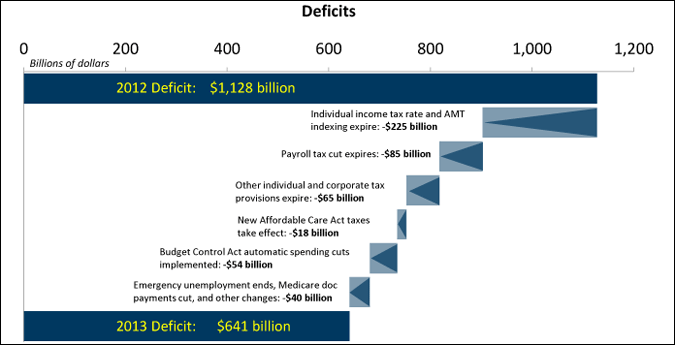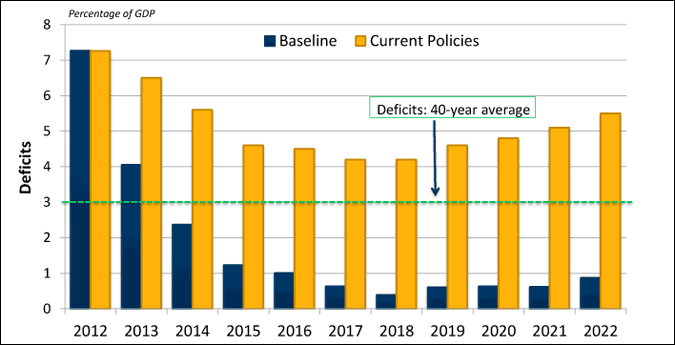You are here
What Is The Fiscal Cliff?
In January 2013, changes in federal tax laws and spending provisions will take effect, reducing the deficit by almost $500 billion — an amount that is so large that it has come to be popularly known as the "fiscal cliff." If all of these changes take place as scheduled, they will almost certainly push the economy back into recession.
The Fiscal Cliff: Policy changes cause deficits to drop by a projected $487 billion between 2012 and 2013.

SOURCE: Data from the Congressional Budget Office, An Update to the Budget and Economic Outlook: Fiscal Years 2012-2022, August 2012. Compiled by PGPF.
The fiscal cliff involves several elements:
- Individual income tax rate and AMT indexing expire: $225 billion. At the end of the year, many of the tax cuts enacted since 2001 will expire. Millions of additional taxpayers will also have to pay the Alternative Minimum Tax (AMT) unless tax law is changed. These expirations would affect nearly all taxpayers.
- Temporary payroll tax cut expires: $85 billion. The 2 percentage point reduction in the employee Social Security payroll tax rate in effect for calendar years 2011 and 2012 is scheduled to expire at the end this year. This tax cut is designed to stimulate the economy by increasing workers’ take home pay.
- Other individual and corporate tax provisions expire: $65 billion. In addition to the rate changes already mentioned above, various other tax provisions are set to expire. The largest of these is a group of rules that permit businesses to partially expense investment property.
- New taxes enacted in the Affordable Care Act (ACA) take effect: $18 billion. The ACA increases tax rates on the earnings and investment income of high-income taxpayers.
- Budget Control Act's automatic spending cuts implemented: $54 billion. As a result of the failure of the congressional “supercommittee" to come up with a deficit reduction plan last fall, across-the-board spending reductions mandated by the Budget Control Act are set to take effect. About half of the reductions will come from defense and half from nondefense programs including education, science and technology, national parks, Medicare, and other entitlements.
- Emergency unemployment ends, Medicare doc payments cut, and other spending changes: $40 billion. An emergency extension of unemployment benefits will expire at the end of the year, saving $34 billion. Unless waived, current law will reduce Medicare payments to physicians by $10 billion — or 27 percent — in January 2013 and by additional amounts in subsequent years. In addition, other policies and economic developments will affect the change in deficits between 2012 and 2013.
In addition, the president and the Congress will also have to come to an agreement in early 2013 to raise the debt ceiling. If they fail to raise it, the government would have to sharply raise taxes, slash spending, or both to keep debt underneath the limit. That could harm the economy and undercut major government programs, including defense, Social Security and Medicare.
By the end of September, Congress and the president are expected to enact a continuing resolution ("CR"), which would keep annually-funded federal operations going until the end of March 2013. (Entitlement benefits like Social Security, Medicare, and Medicaid do not depend on annual appropriations, and their funding is not at risk of being interrupted.) The CR will keep federal agencies open, but will not allow them to start any new initiatives or engage in multi-year commitments. Early next year, the new Congress and administration will have to set funding levels for defense and non-defense programs for the remaining half of the year.
Although reducing the deficit is a desirable goal and can boost long-run economic growth when the economy is strong, the projected sharp and sudden fiscal contraction could damage our weak economy. The Congressional Budget Office projects that unless the fiscal cliff is averted, the economy would fall back into recession in 2013 and the unemployment rate would climb back up to over 9 percent by the end of next year. Moreover, uncertainty posed by the fiscal cliff and the possible resulting recession next year may be already hurting the economy today by undermining consumer and business confidence, according to CBO.
At the same time, simply extending current tax and spending policies would, within the decade, place deficits and debt on a rising path that could harm our economy. If current policies don’t change, CBO projects that debt will climb to 90 percent of GDP within a decade — a level that the agency estimates will begin to slow economic growth — and then soar to an unsustainable and economically damaging 200 percent of GDP within 25 years.
If current policies continue, deficits would remain well above the historical average and rise rapidly by the end of the decade

SOURCE: Data from the Congressional Budget Office, An Update to the Budget and Economic Outlook: Fiscal Years 2012-2022, August 2012. Compiled by PGPF.
What this economy needs is a plan that addresses the fiscal cliff by putting the budget on a sustainable course for the long term that is implemented gradually once the economy has recovered.
